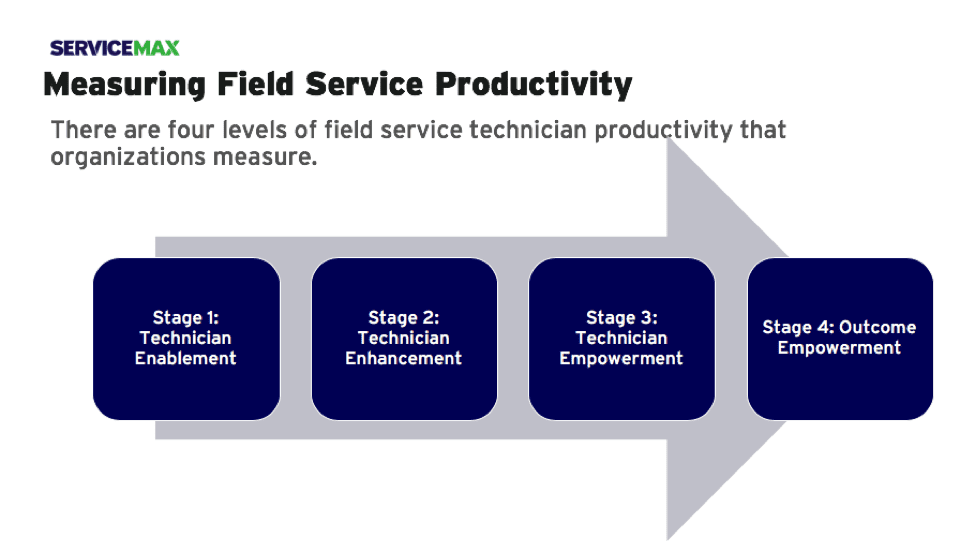In field service, organizations are always striving to boost technician productivity. It’s a core requirement and expectation of any investment in field service. Business cases are built on the basis of expected improved productivity and decisions are evaluated based on their productivity impact. Most organizations have a method in place for measuring field service productivity, and I often find that these methods and models should be augmented with added capabilities and measurements. This idea surfaced in a recent strategy engagement with a large life sciences customer that wanted a better system for tracking field service productivity.
These strategy engagements, a core responsibility of the Global Customer Transformation team, are wonderful ways to track how organizations are transforming their service organizations with the aid of improved tools. My desire to comment on this discussion of productivity was further cemented when I got a chance to review the findings of ServiceMax’s new Impact Report, which highlights the impact customers yield from their use of ServiceMax’s service execution management solution. In my mind, the report outlines the broader impact that technicians have on the overall customer value proposition and a recognition of this true value is integral to the success of any investment in field service.
Back to productivity, my thought is that it should be measured in four stages.
Stage 1: Technician Enablement (Getting to Work)
Measured by:
- Work orders/jobs completed per day and technician utilization
Achieved by:
- Primarily reducing non-productive time attached to paperwork, administrative tasks, or other non-productive tasks. In some scenarios, organizations consider drive time to be non-productive and look to reduce it via better scheduling or routing. In other businesses, drive time is billable and therefore considered to be productive from a revenue generating point-of-view.
Stage 2: Technician Enhancement
Measured by:
- Mean-time-to-repair/service/install (Efficiency of Work)
Achieved by: capabilities in stage 1, plus:
- Reduced time looking for necessary information in work orders, product schematics, instruction manuals and more
- Reduced time looking for service history on a particular asset or piece of installed base
- Reduced time looking for appropriate parts
- Better collaboration with field service experts via communication tools
- Reduced extra (unpaid) work via access to entitlements
- Personalized training/assistance plans due to work-related analytics and dashboards
Most productivity measurement systems typically end at Stages 1 and 2. I would advocate that organizations continue to look at the following.
Stage 3: Technician Empowerment
Measured by:
- First-time fix and parts usage
Achieved by: capabilities in stages 1 and 2, plus:
- Improved diagnosis of service issues prior to scheduling
- Improved scheduling of technicians tied to knowledge, certifications, and parts access
- Ability for technicians to access part inventories (van stock, en route, nearby inventory) needed for work
- Access to onsite collaboration and communication tools in case of diagnosis or repair challenges
Stage 4: Outcome Empowerment
Measured by:
- Technician ability to deliver better customer business outcomes during the time saved in stages 1, 2, and 3..
These outcomes can include:
Customer Outcomes
- Provide guidance and advice on product usage
- Recommend training, parts, products, or other services
- Address other customer needs (billable or otherwise)
Business Outcomes
- Up-sell or cross-sell other products and services
- Identify and record installed base
- Identify and record competitive replacement opportunities
- Assist other technicians via collaborative or other tools
The outcome empowerment stage is significantly important as it typically maximizes the time that the technicians spend in front of the equipment or the customer or both. It provides the technicians the ability to use their knowledge and expertise to drive outcomes that are impactful to the customer and to the service organization. In some instances, these outcomes can generate extra revenue for the organization, better value for the customer and ultimately increase retention and customer satisfaction rates. In some instances, these outcomes might help the service organization get a better handle of its existing installed base.
If we limit ourselves to the productivity definition of jobs completed per technician per day, a saved 45-minutes a day might not amount to much. However, these 45 minutes could be game changing when it comes to the technician’s ability to deliver impactful outcomes.
I’d be extremely interested to get some feedback on this four-stage model ( or @suma1r). Once again, we’re not getting into the incentives or motivation to get technicians to do more, but my hunch is that most technicians are already doing some of the things in stages three and four, but it’s likely that they aren’t being measured, tracked, or rewarded.



Share this: